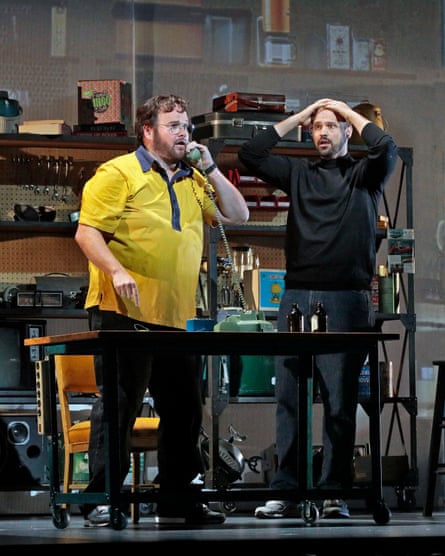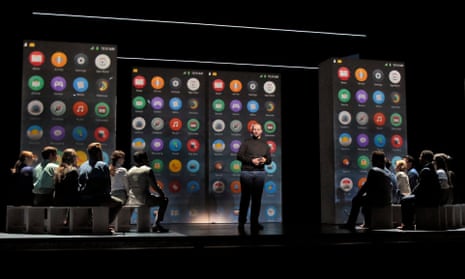When San Francisco bay area-based composer and electronic music DJ Mason Bates recently visited the childhood home of Silicon Valley entrepreneur Steve Jobs, he was in awe.
“It all started in that garage,” Bates said in a hushed, reverent voice, as we pulled up in the composer’s 1970s Alfa Romeo outside the nondescript bungalow at 2066 Crist Drive in Los Altos. Located on an un-trafficked suburban street, the building’s only distinguishing feature was the “no trespassing” sign on the austere patch of lawn out front.
“That’s where he built the early Apple computers,” Bates said, hesitant to get out of the car to take a closer look, lest we disturb the occupants. “That’s where the world’s most valuable company began. In that little garage.”
The fabled garage was designated a historical landmark in 2013. It’s been eulogized in films like Pirates of Silicon Valley (1999) and Jobs (2013), as well as books such as Walter Isaacson’s expansive 2011 biography of the Silicon Valley entrepreneur.
And now that garage has found its way on to the stage in a new opera about Jobs, with music by Bates and libretto by Mark Campbell. The (R)evolution of Steve Jobs opens this weekend at the Santa Fe Opera, a major international festival that unfolds each summer in an open-air amphitheatre, dramatically perched in the desert just north of the New Mexico capital.
The opera careens backwards and forwards between episodes in Jobs’s life. In one scene, he’s launching the iPhone at MacWorld 2007. Then it’s 1974, and he’s dropping acid in an orchard with his girlfriend. Then we’re in 1980, watching Jobs berate his employees at Apple’s corporate headquarters.
The garage is a linking motif through all of this. It’s where the opening scene, circa 1965, between a young Jobs and his adoptive father, Paul, takes place. And it’s a fundamental part of the set design: the garage walls fly apart after the first scene and reform periodically to create different backdrops for the drama as it unfolds.
For Bates that garage, Jobs’s career and Silicon Valley as a whole represent “a place where technology and creativity intersect”. The 40-year-old composer himself has made a career at this intersection.

Bates often uses digital technology in his orchestral works. He’s written pieces that make integral use of electronic sounds for top-tier arts institutions such as the San Francisco Symphony and the Kennedy Center in Washington DC. And he’s often seen sitting in the middle of the orchestra, playing the laptop part in performances of his compositions. In The (R)evolution of Steve Jobs, Bates commands two laptops and an electronic drum pad alongside the other musicians in the pit.
Appropriately, the composer has created a sound world for his new opera’s protagonist that features quicksilver electronics. It includes beeps, pops and whizzes from actual vintage Apple gear, such as the Mac Plus, released in 1986. That particular noise is a prominent feature of the overture.
“While you might not be able to pick out exactly that’s a spinning hard drive of an Apple I, a Power Mac or Mac Plus key click, I think the accumulation of those sounds does lend an authenticity to the sound world,” Bates said.
But it takes more than an authentic sound world to make sense of Jobs’s epic life story on stage. The man ran three major companies: Apple, NeXT and Pixar, where he oversaw the release of many wildly successful products and movies such as the iPhone and Toy Story.
Jobs also had a complicated personal life. He was adopted as a baby; he refused for years to publicly acknowledge his first child, Lisa Brennan-Jobs, the daughter he had out of wedlock in his early twenties with his then girlfriend Chrisann Brennan; and he died young of cancer, at age 56, in 2011.
“He was such a complex individual, I cannot even imagine how you’d capture Steve’s life in an opera,” said Andy Cunningham, who worked closely with Jobs as a publicist during the early years of his three companies. Cunningham witnessed the ups and down of the entrepreneur’s career – and erratic temperament – firsthand.
She said Jobs hired and fired her several times, and once demanded calla lilies for his hotel room at midnight. “Steve was a very emotional person, and he was driven largely by his emotions,” she said.
Other individuals and organizations have also questioned the idea of transforming Jobs’s story into opera.
The San Francisco Opera turned down the opportunity to host the world premiere when Bates and his early collaborator on the project, University of Berkeley arts presenter Cal Performances, approached the opera’s leadership in 2013. (Since the project was workshopped in San Francisco in 2015 and 2016, the organization has come around and will be producing the work in its 2019-2020 season.)
Apple Inc and the Estate of Steve Jobs have not endorsed the opera, and the creators behind The (R)evolution of Steve Jobs take ample liberties with their source material.
This includes radically simplifying Jobs’s story in some ways, to make it fit into two hours of stage time. For instance, it ignores the title character’s significant contribution to the animation industry through Pixar and his years in exile at NeXT, the short-lived computer company Jobs founded after being ousted from Apple in 1985.
But Bates and his collaborators get at the complexity and emotionality of their subject in other ways. “I was fascinated with the tension that is at the center of Jobs’s life: how do you create these sleek and beautiful devices that miniaturize our communication when people are so messy?” Bates said. “People are so complicated. Nobody has one button.”
To reflect this complexity, the composer weaves together intricate theme tunes for each individual character. There’s jazzy brass music for Steve Wozniak, Jobs’s partner in the formative years of Apple; lush strings signify Jobs’s eternally patient and grounded wife, Laurene; and Jobs’s spiritual adviser, Kobun Chino Otogawa, appears against a backdrop of prayer bowls and gongs.
As usual with opera, there’s plenty of drama. But librettist Campbell injects some fun. My favorite example is a garage scene in which Wozniak proudly shows off the circuit board of his brand-new creation, the Apple I computer.
“She sure is ugly,” sings Jobs.
“An interface only a motherboard could love,” Wozniak responds.
And while operatic heroes are usually played by tenors, this one’s a baritone – a darker, more nuanced voice. The American singer Edward Parks plays Jobs in the world premiere production. Equally tall but more heavyset than the emaciated Jobs, the performer cuts an imposing, intense figure on stage.
Dressed throughout in the entrepreneur’s signature uniform of black turtleneck, jeans and sneakers – according to Isaacson’s biography, Jobs ordered more than 100 of those turtlenecks from Japanese designer Issey Miyake – Parks, like a true baritone, isn’t afraid to embrace Jobs’s dark side.
“I’m mostly drawn to his flaws,” Parks said. “The arc of his life is grand. There’s a lot of betrayal, there’s a lot of anger towards people, and there’s a lot of love as well.”
The (R)evolution of Steve Jobs opens July 22 at Santa Fe Opera in Santa Fe, New Mexico.

Comments (…)
Sign in or create your Guardian account to join the discussion